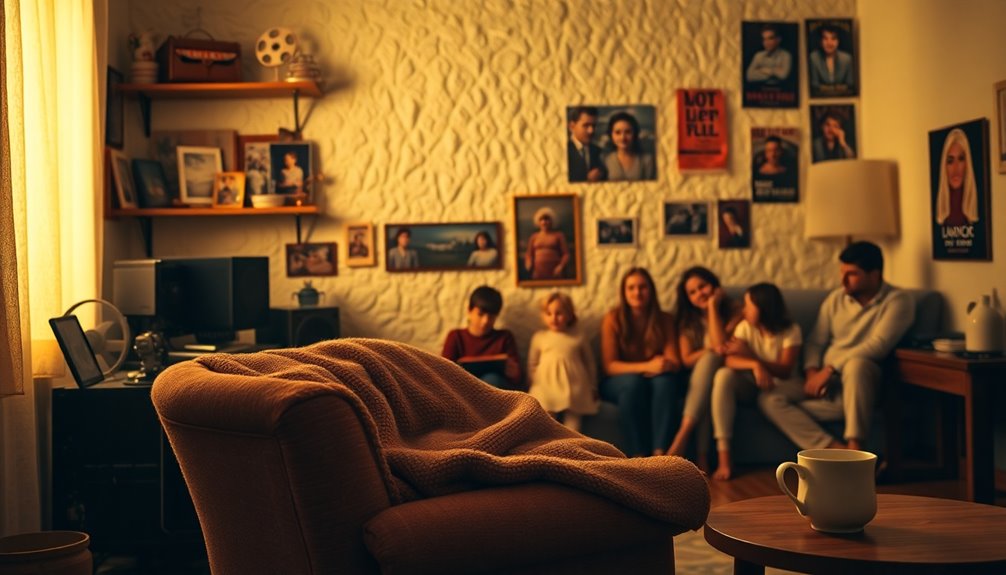In the Memory Lane Masterclass, you’ll learn how to curate your family history through classic films and documentaries. You’ll find ways to preserve cherished memories and connect generations by creating engaging visual narratives. By gathering materials like photographs and letters, you can weave a compelling story of your family’s journey. Professional filmmaking can elevate your project, ensuring it resonates deeply. Stick around, and you’ll uncover more insights on preserving your family’s legacy.
Key Takeaways
- Explore the significance of family history films in preserving memories and connecting generations through visual storytelling.
- Gather and organize photographs, letters, and artifacts to create a meaningful narrative of your family’s journey.
- Develop a compelling documentary outline that includes interviews and archival materials for depth and personal insights.
- Consider hiring professional filmmakers to enhance the emotional impact and cinematic quality of the family documentary.
- Complement your film with written narratives and digital backups to ensure the family’s legacy is preserved for future generations.

Curating family history through films and documentaries offers a unique way to preserve cherished memories and connect generations. By turning your family’s stories into visual narratives, you create a powerful medium that captures experiences and emotions, enabling future generations to understand their roots. These films not only document pivotal moments in your family’s journey but also foster a sense of identity and belonging among viewers.
To start, gathering materials is essential. Dig through old boxes and gather photographs, letters, and other artifacts that hold significance. Each item tells a piece of your family’s story, so take the time to sift through them, determining which ones are most impactful. This curation process helps you organize the collection meaningfully, making it easier to weave a compelling narrative later. You might even consider reaching out for professional assistance if your collection is extensive or complex.
Once you’ve gathered your materials, think about how to create an engaging documentary. A great film begins with a story. Outline key events and experiences that shaped your family’s history. Incorporate archival footage and photographs to bring the narrative to life. This visual enhancement adds depth and makes the story relatable. Conducting interviews with family members can provide personal insights, enriching the documentary with unique perspectives and voices. Professional filmmakers bring expert skills to ensure that heartfelt responses are elicited during these interviews.
Professional filmmaking can significantly elevate your project. Investing in cinematic excellence not only enhances the film’s emotional impact but also serves as a tribute to your family’s legacy. A well-crafted documentary showcases respect for their story and ensures that it resonates with a broader audience. You can share your film at family gatherings, film festivals, or even streaming platforms, allowing more people to connect with your narrative.
Preserving family histories doesn’t stop with the film. Consider writing a narrative that complements your documentary, creating a comprehensive account of your family’s journey. Self-publishing offers an accessible way to share this legacy with loved ones, while digital backups ensure that your family’s stories remain intact for future generations.
Frequently Asked Questions
How Do I Choose the Right Films for My Family History?
To choose the right films for your family history, start by considering emotional resonance.
Look for films that evoke feelings tied to your heritage. Check for historical accuracy to ensure the stories are credible and informative.
Don’t forget educational value; films that explain genealogical methods can enhance your understanding.
Lastly, think about personal relevance—select films that connect with your family’s unique story, making the viewing experience more impactful and meaningful.
Can I Include Personal Videos in My Documentary Project?
Absolutely, you can include personal videos in your documentary project! They add a unique emotional connection and authenticity by showcasing real voices and experiences.
Just make sure to organize your footage properly and address any quality issues during editing.
You’ll want to secure consent from everyone involved to respect their privacy.
Using professional editing software can help integrate these personal videos seamlessly, making your documentary more engaging for viewers.
What Equipment Do I Need to Create a Family Documentary?
Creating a family documentary‘s like piecing together a beautiful quilt.
You’ll need a reliable video camera, preferably 4K or HD, to capture those precious moments.
Invest in a 3-point lighting setup to brighten your scenes, and don’t forget an external microphone for clear audio.
A portable digital recorder, editing software, and external hard drives for backup will keep everything organized.
With these tools, you’re ready to weave your family’s story!
How Long Should a Family Documentary Typically Be?
When you’re creating a family documentary, its length typically ranges from 15 to 30 minutes for casual sharing, while TV broadcasts often run 30 to 60 minutes.
You’ll want to match the length with your content’s depth, ensuring it stays engaging without dragging on. Shorter films can captivate casual viewers, whereas longer ones allow for more detailed storytelling.
Focus on what best showcases your family’s narrative to keep your audience invested.
Are There Specific Editing Software Recommendations for Beginners?
Are you wondering which video editing software is best for beginners? You’ve got some great options!
Adobe Premiere Elements is user-friendly and perfect for transitioning to more advanced tools.
CyberLink PowerDirector combines an easy interface with powerful features, while Wondershare Filmora offers AI-driven tools for simpler editing.
If you prefer mobile apps, CapCut and Adobe Premiere Rush are fantastic choices. Each provides tutorials to help you get started on your editing journey!
Conclusion
As you explore classic films and documentaries, you’re not just watching stories; you’re connecting with your family’s past in a powerful way. Each scene offers a window into history, inviting you to reflect on your own roots. Isn’t it fascinating how these cinematic narratives can help you piece together your family’s journey? By curating these memories, you’re preserving a legacy that will resonate for generations to come, transforming your viewing experience into a meaningful exploration of identity. Furthermore, as you immerse yourself in these films, you may find inspiration in the ongoing golden age cinema revival, which celebrates the timeless themes and narratives that continue to shape our understanding of family and heritage. Watching these classics not only deepens your appreciation for artistic craftsmanship but also highlights the enduring relevance of shared stories across generations. In this way, your viewing becomes more than just entertainment; it evolves into a vital act of remembering and honoring the legacy that binds us all together.









